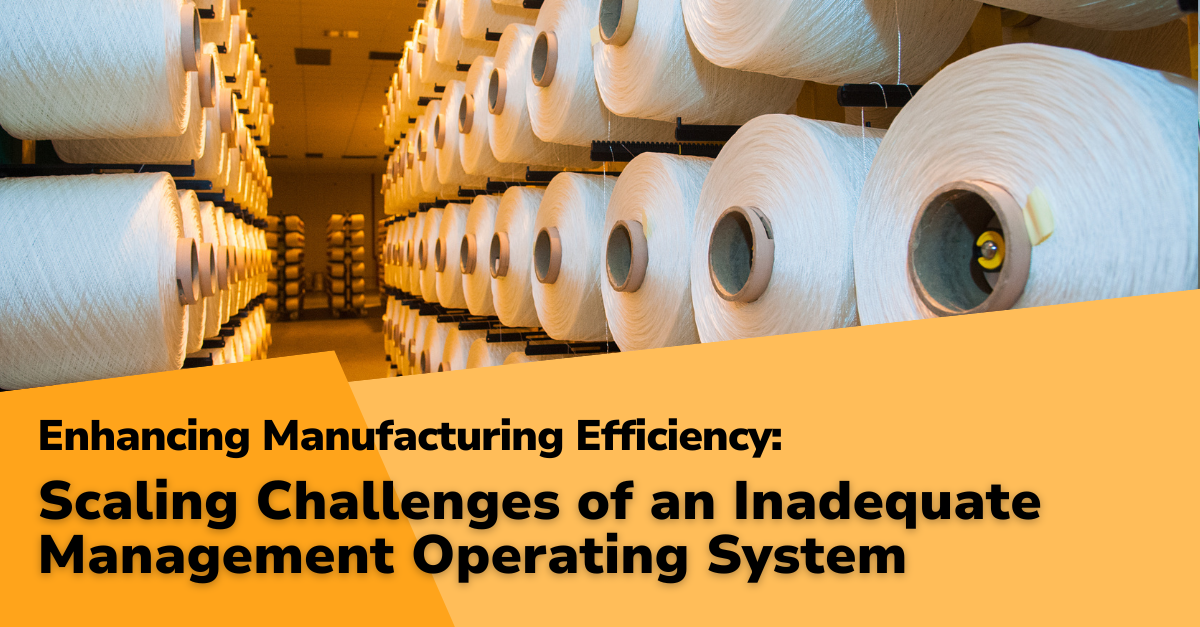
When a manufacturer hits a wall trying to scale, the culprit is often hiding in plain sight: a Management Operating System (MOS) that doesn’t scale with the business.
A well-structured MOS isn’t just helpful for growth, it’s essential. It gives leadership real-time visibility, aligns resources with demand, and ensures the operation can absorb complexity without breaking stride. But when that system is missing or poorly implemented, expansion efforts tend to fall apart fast. Critical decisions get delayed, execution suffers, and valuable opportunities slip away.
In this sixth installment of our Enhancing Manufacturing Efficiency Mastery Series, we’re zeroing in on how a weak or underdeveloped MOS quietly sabotages your ability to grow. From fragmented process management to market share erosion, here are the 10 most common (and costly) ways a broken MOS can block your path to scale, and how to recognize the warning signs before they become revenue leaks.
1Fragmented Process Management:
As operations expand, coordination becomes more critical, and more difficult. Without a unified MOS, each team ends up running its own version of the plan. Processes drift, standards become inconsistent, and interdepartmental communication breaks down. This fragmentation fuels inefficiencies that only get worse as you grow. When every new order or customer introduces more variability, disjointed processes slow everything down and increase the risk of error.
Even small process gaps can compound into major delays or quality issues when left unaddressed. A strong MOS keeps teams aligned and workflows synchronized, especially under pressure.
2Limited Visibility into Operations:
You can’t scale what you can’t see. A weak MOS leaves operations leaders guessing, relying on outdated reports, spreadsheets, or anecdotal feedback to make critical decisions. That limited visibility delays response times and creates blind spots that lead to resource waste, missed opportunities, and poor planning.
Growth demands real-time awareness across people, equipment, and workflows. If your team can’t instantly answer questions like “Where’s our next constraint?” or “Why are we missing this target?” then scaling becomes more reactive than strategic.
3Inadequate Infrastructure:
Outdated equipment, overcrowded layouts, and underbuilt systems quickly become a ceiling to growth. But without a MOS that connects operational performance to infrastructure capacity, those limitations often stay hidden until they cause failure, unexpected downtime, bottlenecks, or customer delays.
A scalable MOS flags where you’re hitting physical limits and helps prioritize investments. It brings clarity to expansion planning, helping you avoid overspending or underbuilding as you grow into new markets or product lines.
4Ineffective Resource Allocation:
Growth stretches resources in every direction, labor, materials, machines, and capital. Without clear priorities and performance tracking, teams often misallocate what they have. Overtime rises in low-impact areas. High-margin lines get short-staffed. Inventory piles up where it’s not needed and runs short where it is.
An effective MOS aligns resource planning with operational goals. It gives frontline leaders and managers the information they need to rebalance quickly, reduce waste, and make the most of every hour and dollar.
5Difficulty in Managing Increased Complexity:
Growth brings new SKUs, more production lines, broader supply chains, and shifting customer requirements. With that comes complexity, not just more of the same, but more variation in what you’re producing and how you’re managing it.
Without a structured MOS, complexity turns into chaos. Teams improvise. Quality slips. Information gets lost between handoffs. Leaders spend more time chasing symptoms than solving root causes. A scalable MOS introduces standardization, visual controls, and daily accountability structures that keep complexity manageable and productivity steady, even as the business evolves.
6Capacity Constraints:
One of the clearest signs that your MOS isn’t scaling is when your operation simply can’t keep up with demand. Orders get delayed. Changeovers take too long. Downtime creeps up. The line is always “at capacity,” but somehow still behind.
Without the visibility to anticipate future capacity needs, or the tools to optimize current capacity, teams stay stuck in reaction mode. An effective MOS helps you model future demand, identify pinch points, and build flexibility into your processes, so you can scale up without losing control.
7Technology Gaps:
Data is the lifeblood of a scalable operation. But if your MOS is disconnected from your tech stack, or still reliant on clipboards and batch reporting, you’re likely making decisions too late, or on incomplete information.
That disconnect leads to missed improvement opportunities, slow problem resolution, and costly trial-and-error fixes. A modern MOS closes those gaps by integrating digital tools, visual dashboards, and alerts that bring clarity to the floor and confidence to decision-making. When your data works in real time, so does your operation.
8Workforce Management Challenges:
Scaling often means hiring new people, upskilling current ones, and shifting how teams work. But without a clear structure to guide behavior and performance, workforce issues multiply. Productivity stalls, engagement dips, and turnover rises, especially when new employees aren’t set up to succeed.
An effective MOS creates consistency in expectations, routines, and coaching. It empowers frontline leaders to lead proactively, not just react to problems. And it ensures that workforce capacity keeps pace with business growth, not the other way around.
9Financial Constraints and Cash Flow Issues:
Growth consumes cash, but when the MOS doesn’t track ROI, OEE, or cost per unit in real time, it becomes difficult to justify or direct that spend effectively. That leads to bloated budgets in low-return areas and starved resources where you need them most.
Financial inefficiencies at scale become dangerous. Without performance-based planning and fast feedback loops, operations leaders are stuck defending past decisions rather than improving future outcomes. A strong MOS links financial health to operational performance, helping companies invest smarter at every stage of growth.
10Market Share Erosion :
Your competition isn’t standing still, and if they’re scaling faster and more efficiently, they’re taking your market with them. Customers notice when delivery times slip, quality dips, or your team can’t respond quickly to changes. And once that reputation takes a hit, it’s hard to recover.
A fully optimized MOS enables you to meet demand consistently, adapt quickly, and build trust with customers as you grow. It becomes a strategic advantage, turning operational discipline into customer confidence and long-term loyalty.
Scaling Without the Guesswork
Too many manufacturers try to grow by pushing harder instead of operating smarter. But without a strong MOS to support that growth, teams end up stuck in firefighting mode, working more, delivering less, and burning out before they break through.
The POWERS Difference
At POWERS, we help manufacturers build and implement the kind of MOS that grows with the business, not against it. We don’t drop in templates and walk away. We work shoulder-to-shoulder with your leadership and frontline teams to create lasting systems that drive results.
- Tailored Solutions: We design MOS solutions specifically suited to each manufacturing context, addressing unique quality and operational challenges.
- Comprehensive Integration: Beyond implementation, we integrate the MOS into your organizational culture and processes for a cohesive operational framework.
- Empowering People and Processes: Our strategy is to engage and train employees at all levels to maintain and enhance quality standards.
- Data-Driven Decision-Making: Our proprietary Digital Production System (DPS) gives you real-time dashboards, performance alerts, and coaching insights that scale alongside your business.
- Proven Expertise: With a history of successful MOS implementations, we bring deep insights into enhancing quality and efficiency in manufacturing.
Partner with POWERS to ensure your company’s ability to scale operations effectively through an optimized MOS. Start your journey toward a more sustainable, scalable, and profitable business today.
Unlock the full potential of a robust Management Operating System with POWERS and set your path toward unparalleled operational excellence. For expert guidance and solutions tailored to your unique operational challenges, contact our team at +1 678-971-4711 or email info@thepowerscompany.com.
Continue Reading from this Mastery Series
- Part 1 - Identifying Key Inefficiencies in the Absence of a Management Operating System
- Part 2 - Top 10 Pitfalls: Lack of an MOS Derails Productivity
- Part 3 - Top 10 Quality Issues at Risk Without a Robust Management Operating System
- Part 4 - The High Cost of an Ineffective Management Operating System
- Part 5 - Without an Optimized Management Operating System, Decision-Making is Severely Impaired
- Part 6 - Scaling Challenges of an Inadequate Management Operating System
- Part 7 - The High Price of Low Engagement: Unpacking the Operational Impact of Employee Discontent
- Part 8 - Safeguarding Success: Decoding the Impact of Compliance and Safety Issues
- Part 9 - Examining the Cost of a Slow Response to Market Shifts
- Part 10 - Charting Success: Understanding the Costs of Losing Competitive Advantage







